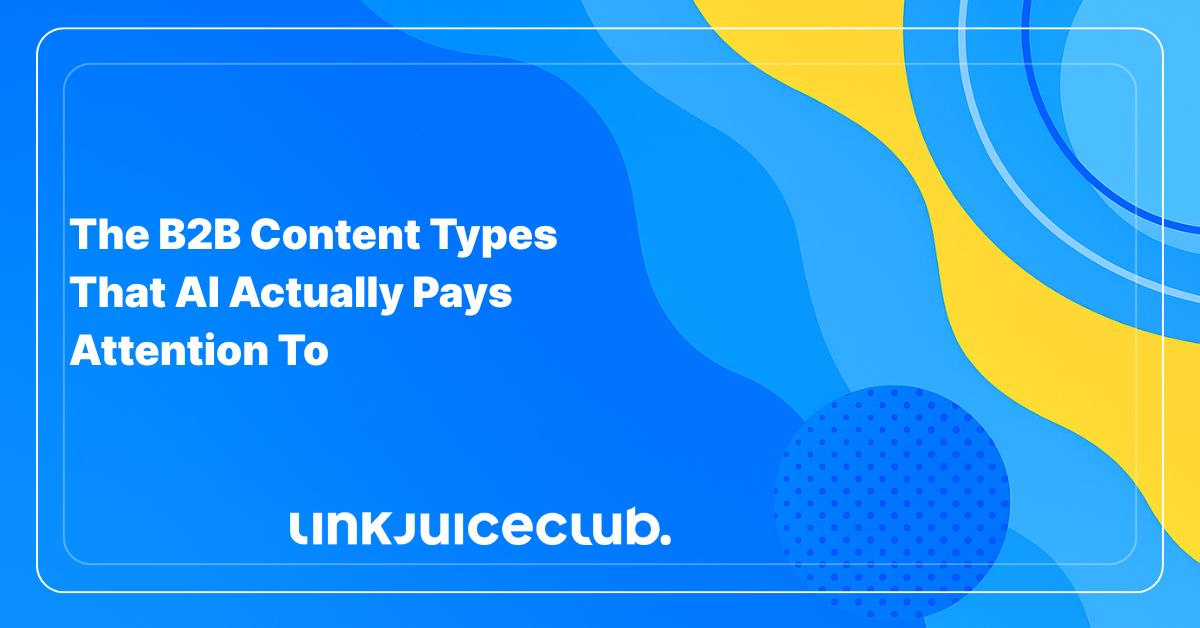
The B2B Content Types That AI Actually Pays Attention To
AI search isn’t magic; it’s math. And right now, that math heavily favors content that’s structured, specific, and built for context.
Not all B2B content types make the cut. In fact, most of them get completely ignored.
So, if you’re wondering which B2B content types still stand a chance in a landscape where robots are in charge, this is where you start. Let’s break down what’s working, why it’s working, and how to make it work for you.

1. Everyone Googles X vs. Y
Turns out, AI does too. Gemini has a soft spot for comparison pages, even when nobody asks for one.
Someone might just search best CRM for healthcare, but the model still pulls up side-by-side comparisons. Why? Because AI doesn’t like giving a single answer; it prefers showing options, with context.
If your product is in a crowded market (and let’s face it, it probably is), you need to create comparison pages that clearly explain how you stack up.
Think beyond marketing fluff. Add honest pros and cons, pricing breakdowns, who each tool is best for, and structured data to help AI understand what’s on the page.
2. Your Product Docs Should Be More Than Just Help Articles
If you’re still treating product documentation like some dusty corner of your website, you’re going to get ghosted by Gemini.
AI models now pull hard from help centers and product pages, especially if they’re built with structure in mind. We’re talking proper FAQs, clear how-to walkthroughs, and semantic clues like breadcrumbs and schema that help LLMs know where the good stuff lives.
The trick here isn’t just dumping text into your docs. It’s thinking like an LLM: What would a machine need to extract value from this page?
Want to Rank in AI Search? Play by the New Rules
While E-E-A-T still matters, AI search engines like ChatGPT and Gemini are working off a different blueprint.
They’re dissecting, sampling, and remixing your content into answers. If you want your brand to surface in LLM-generated responses, it’s time to level up your content strategy.
Build for Multi-Format Discovery
AI tools love variety. To stay visible, your content needs to speak multiple languages.
Make your visuals AI-friendly by keeping your HTML clean and crawlable. Avoid hiding images behind JavaScript or lazy-loading tricks; LLM scrapers might skip over them entirely.
Use descriptive alt text that actually explains the image’s purpose, not just graph1.png. Add captions or explanations next to charts and diagrams to give them immediate context.
And for tables? Never upload them as images. Use real HTML tables so machines can read and summarize them without guessing.
Think in Chunks, Not Pages
LLMs don’t care about your beautifully written 2,000-word blog post. They’re more interested in the three useful paragraphs buried in the middle.
AI search works by slicing content into bite-sized chunks and choosing the best ones for a given query. That means every section of your content needs to pull its own weight.
Write each section as if it could stand on its own. Keep it tightly focused on one idea, and avoid burying key points under fluff or tangents. Use clear subheadings (H2s and H3s) to label each section like a chapter title. The goal is semantic clarity – every passage should be understandable without needing to scroll up for context.
Write Like You’ll Be Quoted
AI search doesn’t just retrieve content; it stitches together multiple sources into a coherent answer. That means your content needs to be crystal clear, well-structured, and easy to extract.
Start strong. Use a clear, one-sentence answer before diving into details. Break down complex topics into short, scannable takeaways. If you can, structure important sections in a natural Q&A format. LLMs love pulling answers that feel like direct responses to user prompts. Skip the sales fluff and aim for a tone that’s factual, helpful, and human.
Also, use structured data wherever possible. FAQs, how-to markup, product schemas, these help AI figure out what your content is actually about, which means a higher chance of it making the cut in AI search results.
Follow the Rules for B2B Content Types That AI Actually Wants
If you want to stay visible in the age of LLMs, you can’t rely on old SEO tactics alone. The rules are shifting (and fast). The smartest brands are adapting.
That starts by rethinking your B2B content types not as blog fodder, but as strategic building blocks for AI discovery.
AI models want clean, well-structured content they can actually use. That’s why comparison pages and detailed product docs perform so well. The more focused and clearly organized your B2B content types are, the more likely they are to get picked up, referenced, and trusted.
In short: the age of write it and hope is over. Create B2B content types that are designed to be understood at a glance and you won’t just keep up. You’ll lead.





